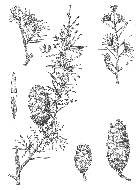Conservation Status

Nothotsuga longibracteata
(Cheng) Hu ex C.N. Page (1988)
Common names
Bristlecone hemlock (Farjon 1990), 长苞铁杉 chang bao tie shan [Chinese] (Wu and Raven 1999).
Taxonomic notes
This is the sole species in Nothotsuga Hu ex C.N. Page (syn.: Tsugo-Keteleeria Van Campo-Duplan et Gaussen, nom. illeg.; Nothotsuga Hu, nom. nud.).
Synonymy: see POWO. None of the synonyms are in recent use.
This species differs strikingly from species of Tsuga as follows: leaves radially spreading, stomatal lines present on each surface; pollen cones clustered in umbels from a single lateral bud; seed cones nearly erect; bracts with a slightly exserted, apical cusp (Wu and Raven 1999). The validity of this taxon at genus rank is also confirmed by molecular work; in terms of both chloroplast and molecular markers, its genome is about twice as divergent from Tsuga as the most distantly related species of Tsuga are from each other (Havill et al. 2008).
Description
Trees to 30 m tall and 100 cm dbh. Bark dark brown, longitudinally fissured. Branchlets drying brownish yellow or reddish brown, aging brown-gray or dark brown, glabrous. Leaves with petiole 1-1.5 mm; blade 11-20(-24) × 1-2(-2.5) mm, smooth or faintly grooved, stomatal lines 7-12 adaxially, 10-16 along each surface abaxially, apex acute to slightly obtuse. Seed cones purplish or red, maturing to dark brown, 2-5.8 × 1.2-2.5 cm, persisting several years, then breaking off whole or sometimes disintegrating. Seed scales at middle of cones broadly rhombic or suborbicular, 0.9-2.2 × 1.2-2.5 cm, base peltate-auriculate, apex truncate-rounded. Bracts subspatulate, 0.7-1.8 cm, apical cusp acute or acuminate. Seeds triangular-ovoid, 4-8 × 2.5-3 mm; wing ovate-oblong, apex rounded. Pollination March-April, seed maturity October (Wu and Raven 1999).
Distribution and Ecology
China: NE Guizhou, SW Hunan, N Guangdong, NE Guangxi & S Fujian (Farjon 1990). Hardy to Zone 8 (cold hardiness limit between -12.1°C and -6.7°C) (Bannister and Neuner 2001).
Forming small, pure stands, or in evergreen, broad-leaved, sclerophyllous forests (species of Castanopsis, Lithocarpus, and Quercus), or mixed, mesophytic forests (Fagus longipetiolata, Pinus kwangtungensis, Tetracentron sinensis, etc.) on steep, sunny mountain slopes and ridges on acidic soils in areas with cool, temperate, humid climate and abundant rainfall and fog; (300-)400-1900(-2300) m. C and S Fujian, N Guangdong, C and N Guangxi, E Guizhou, S Hunan, S Jiangxi (Wu and Raven 1999).
The IUCN in 2010 assessed Nothotsuga as "Near Threatened" due to native vulnerability (a narrow ecological niche and a scattered, fragmented distribution), combined with effects from past logging and general deforestation (Farjon et al. 2013).
Remarkable Specimens
Chen et al. (2015) report on a 174-year tree-ring chronology for this species, suggesting the possible occurrence of living trees that old.
Ethnobotany
This is an ideal tree for afforestation in mountains above middle elevations in subtropical regions. The timber is used for construction and furniture (Wu and Raven 1999).
Observations
No information as of 2025.02.18.
Remarks
The epithet refers to the long bracts that are slightly exserted, a feature not seen in any species of Tsuga.
Citations
Chen, Feng, Yujiang Yuan, Wenshou Wei, Shulong Yu, and Huiqing Wang. 2015. Tree-ring response of subtropical tree species in southeast China on regional climate and sea-surface temperature variations. Trees 29:17-24.
Farjon, Aljos. 1990. Pinaceae: drawings and descriptions of the genera Abies, Cedrus, Pseudolarix, Keteleeria, Nothotsuga, Tsuga, Cathaya, Pseudotsuga, Larix and Picea. Königstein: Koeltz Scientific Books.
Farjon, A., T. Christian, and D. Zhang. 2013. Nothotsuga longibracteata. The IUCN Red List of Threatened Species 2013: e.T34162A2848919. https://dx.doi.org/10.2305/IUCN.UK.2013-1.RLTS.T34162A2848919.en, accessed 2025.02.18.
Havill, Nathan P., Christopher S. Campbell, Thomas F. Vining, Ben LePage, Randall J. Bayer, and Michael J. Donoghue. 2008. Phylogeny and biogeography of Tsuga (Pinaceae) inferred from nuclear ribosomal ITS and chloroplast DNA sequence data. Systematic Botany 33(3):478–489.
Page, Christopher N. 1988. New and maintained genera in the conifer families Podocarpaceae and Pinaceae.
Notes from the Royal Botanic Garden, Edinburgh 45(2):377–395.
See also
The species account at Threatened Conifers of the World.




